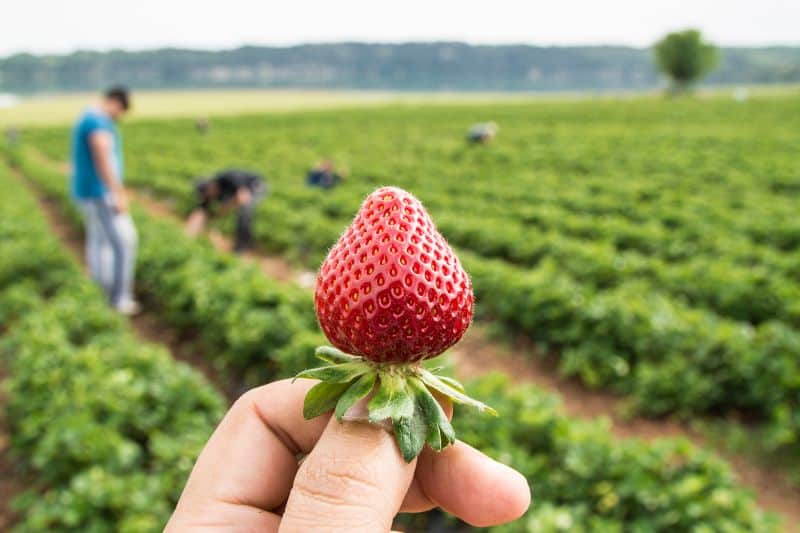With their sweet and fruity flavor, strawberries are a great fruit to add to your cooking recipes, and they’re filled with healthy antioxidants. Growing them is relatively easy as strawberry plants can tolerate various soil conditions. However, do strawberries need full sun?
Strawberries need to be planted in garden areas that receive full-sun conditions. Whether you grow strawberries in the garden or in containers, you must ensure they get many hours of sunlight daily. When strawberries don’t get enough light, this will affect their taste, giving them an acidic flavor.
Although strawberries naturally have a slightly acidic taste, they won’t be pleasant to consume if they’re acidic or sour. A lack of sunlight will also cause them to experience growth challenges.
Read: Do Azaleas Need Full Sun or Shade? (Answered)
Do Strawberry Plants Need Full Sun?
If you don’t have a sunny garden, you might worry that you can’t grow strawberries. Although a bit of shade won’t harm your strawberry plants, they require lots of direct sunshine daily to be healthy.
Strawberry plants need full-sun conditions, requiring at least six hours of direct sun daily. Your strawberry plant won’t produce much fruit if you don’t meet these requirements. Any fruit that does appear on the plant will be small.
Strawberries use sunlight to complete many important functions to ensure they grow healthy, such as having enough resources to produce large and tasty fruit.
Can Strawberries Get Too Much Sun?
Although strawberries are sun worshippers, they can struggle to grow if they get too much sun. This isn’t so much about the sunlight itself, but rather the heat they’re exposed to, as this can cause them to experience sun scorch.
Strawberries can suffer from too much sun if temperatures exceed 38°C (100°F). The heat will dry them out and cause their leaves to fall. High temperatures will cause the strawberries on the plant to be dry instead of juicy.
This is why it’s essential to keep an eye on the temperature in your garden. If your region isn’t getting a lot of rain and the summer temperature is high, you should protect your strawberry plants from damage. This can take the form of covering your strawberry plants with a canopy during hot days to provide some shade.
When planting strawberry plants, ensure you keep them at least 12 inches (30.48cm) away from each other so that they get enough air circulation to keep them cool and prevent the heat from damaging them. Planting strawberry plants on higher ground is a good idea because it enhances air circulation between plants while reducing the risk of frost damage.
How Much Sun Do Strawberries Require?
Although you should aim to give your strawberry plants around six hours of sunshine daily to make them grow juicy strawberries and lush green foliage, the more sunshine you can give them, the better.
Ideally, strawberry plants do best when given 10 hours of direct sunlight daily. They should, therefore, be planted in the sunniest spot in the garden. Avoid planting strawberries too close to other plants, trees, walls, and garden structures that block out the light.
Check the site where you want to plant your strawberries to ensure that nothing is blocking the sun. And don’t forget to protect them from arid and hot conditions, especially during afternoons, so that the heat doesn’t harm them.
Strawberry Varieties and Their Sunlight Needs
There are three main categories of strawberries:
- June-bearing strawberries
- Everbearing strawberries
- Day-neutral strawberries
June-bearing Strawberries
These strawberry plants are the most common in the U.S., with varieties including Jewel, Eclair, and Kent. They produce one harvest of strawberries in June every year, hence their name. June-bearing strawberries produce a high yield with sweet fruit.
They require at least six hours of sunlight every day and one inch (2.54cm) of water per week to keep their soil moist during the growing season. When their flowers appear during the growing season, June-bearing strawberries should have their blossoms removed to promote the development of their roots and produce larger crops.
Everbearing Strawberries
You can expect to harvest two everbearing strawberry crops every season: one appears in the middle of spring and the other can be seen in the late summer or early fall. The plants require full sun conditions to ensure two harvests, so give them at least six hours of sun per day.
However, protect them from the harsh afternoon sun during the hottest days of the season to prevent their foliage from burning, which can lead to a reduced crop.
You don’t have to worry too much about humidity and temperature when growing everbearing strawberries because giving them enough sun and water so they will produce juicy fruit is the most important way to get a delicious yield. Examples of everbearing strawberries include Everest, Quinalt, and Ozark Beauty.

Day-Neutral Strawberries
If you want to grow strawberries throughout the growing season, consider planting day-neutral strawberry plants. Like everbearing varieties, day-neutral strawberries produce smaller yields with smaller fruits than June-bearing plants. However, they should also get at least six hours of sun daily.
These fruit plants get their name because their crop isn’t affected by day length like other plants. Instead of being exposed to direct sunlight, day-neutral strawberry plants are usually grown underneath protected culture, such as tunnels. They need temperatures of between 45 and 85° F (7.2-29.4°C) to grow healthy. Examples of day-neutral strawberries include Seascape and Tristar.
Note: Although most strawberry varieties need many hours of sunlight daily, a wild strawberry plant called ‘Alpine’ can grow in the shade. This wild strawberry plant grows in nature in forests around the world.
Although it bears fruit, its strawberries are smaller and don’t produce a high yield compared to other strawberry varieties. You can grow ‘Alpine’ strawberries in your garden, but they require about four hours of sun every day.
Challenges Faced By Strawberries in Full Sun
Although all strawberry varieties thrive in full-sun conditions, there are some precautions you need to take so that the sun doesn’t damage them. Strawberries are susceptible to heat-related problems like sun scorch.
Sun scorch strikes plants when the weather is dry, windy, or there’s a lot of bright sunshine. It affects the roots of plants, making them dry so that they can’t transport water to the leaves. So, if your strawberry plant’s leaves are drying out or drooping, these are signs the plant isn’t getting the moisture and air circulation it needs.
Other Problems Caused by Too Much Sun
Another condition that can pose challenges when growing strawberries is sunburn. This is when the sun burns the plant, and symptoms can appear on its fruit and leaves. Symptoms include a softer fruit texture and pale, pink fruit instead of the bright red color strawberries should have. You’ll also notice dark leather-like areas on the fruit exposed to the sun.
When temperatures exceed about 38°F (100°C), strawberry plants will be exposed to too much heat that prevents them from forming blossoms, but they will produce more green foliage and runners, known as stolons.
This is problematic for the plants because when they put all their resources into forming stolons, they don’t have any to produce fruit. The result is your plant will have smaller strawberries. In some cases, the plant won’t bear any fruit at all.
If you live in a region that experiences hot summers, a guideline to follow when finding the perfect site for strawberry plants is to choose an area where they’ll get bright morning sun and dappled afternoon sun, so it’s not harsh. Water your strawberries when the surface inch (2.54cm) of soil feels dry to prevent them from drying out.
Read: Do Hydrangea Need Full Sun or Shade? (Answered)
What Happens if Strawberries Don’t Get Enough Sun?
Unless you’re growing ‘Alpine’ strawberries that don’t require as much sun as other varieties, you must ensure that your strawberry plants have direct sun for between six and 10 hours per day.
If strawberries don’t get much sunlight, they’ll struggle to produce healthy, vibrant fruit. The strawberries will be smaller in size, and you won’t get a large yield on the plant. Sunlight gives plants the energy they require to produce sweet, large strawberries.
Strawberries that haven’t received enough sunlight might also be misshapen. This commonly occurs if the plants are exposed to cloudy weather. If your region experiences high rainfall, the lack of sun causes bees to become less active, inhibiting the plant’s flowers from pollinating properly. This degrades the quality of the fruit.
Another common problem you’ll notice in your strawberry plants if they’re not getting enough light is legginess. This refers to how the plants grow too tall and thin because they stretch to reach the light.
When plants are leggy, they are more fragile than healthy plants and might even take on a paler appearance, so it’s essential to find a warm, sunny spot where your strawberries can receive enough sunshine.






